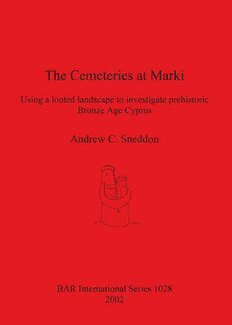
The Cemeteries at Marki: Using a looted landscape to investigate prehistoric Bronze Age Cyprus PDF
291 Pages·2002·28.064 MB·English
Most books are stored in the elastic cloud where traffic is expensive. For this reason, we have a limit on daily download.
Preview The Cemeteries at Marki: Using a looted landscape to investigate prehistoric Bronze Age Cyprus
Description:
This monograph presents the results of an intensive site survey of three Prehistoric Bronze Age cemeteries in the vicinity of Marki Alonia in central Cyprus. These cemeteries contained around 370 pit and chamber tombs, and were in use from the Early Cypriot Bronze Age into the Middle Cypriot period. Each of the cemeteries has been looted since the Second World War, with the result that a sizable scatter of ceramic artefacts lies across their surfaces. It is this scatter that forms the main subject of this work. Marki's cemeteries provided an important opportunity to assess the value of looted sites to archaeologists. The taphonic processes that have affected the sites are therefore discussed in detail, with the conclusion that although cultural and natural processes can significantly affect a ceramic assemblage from a looted cemetery, they do not render them valueless. The work concludes that the ceramics interred in Prehistoric Bronze Age cemeteries differed little from those used in day-to-day life in the settlement, and that although mortuary assemblages from across Cyprus were generally similar, some idiosyncrasies existed from site to site. Additionally, the study considers issues of social complexity, chronology, burial customs, and symbolic behaviour.
See more
The list of books you might like
Most books are stored in the elastic cloud where traffic is expensive. For this reason, we have a limit on daily download.
